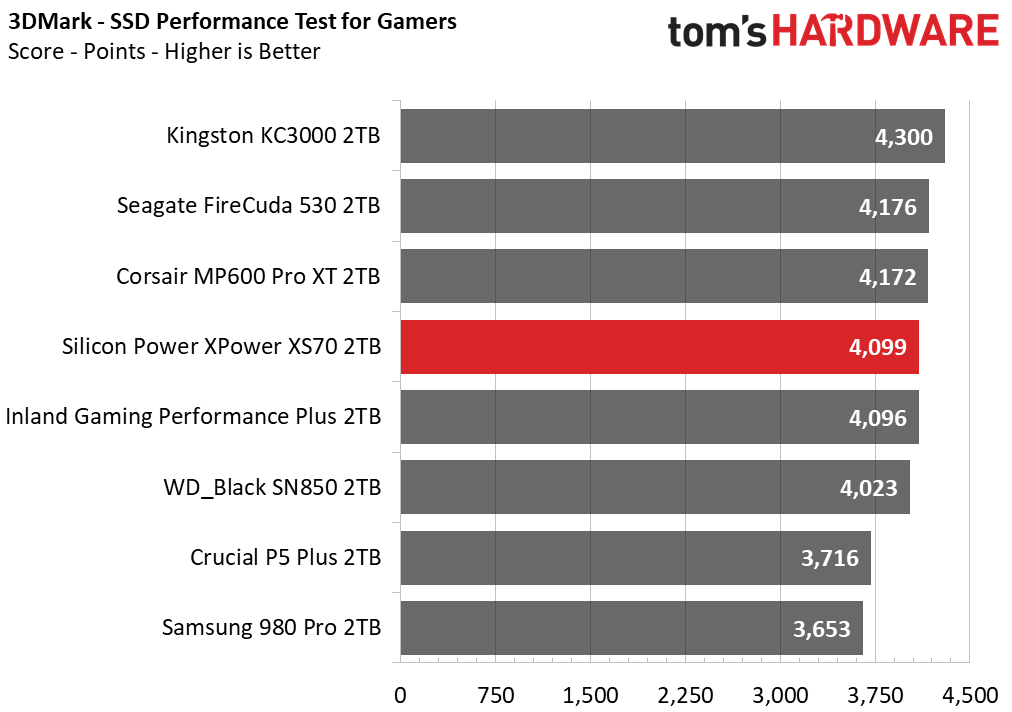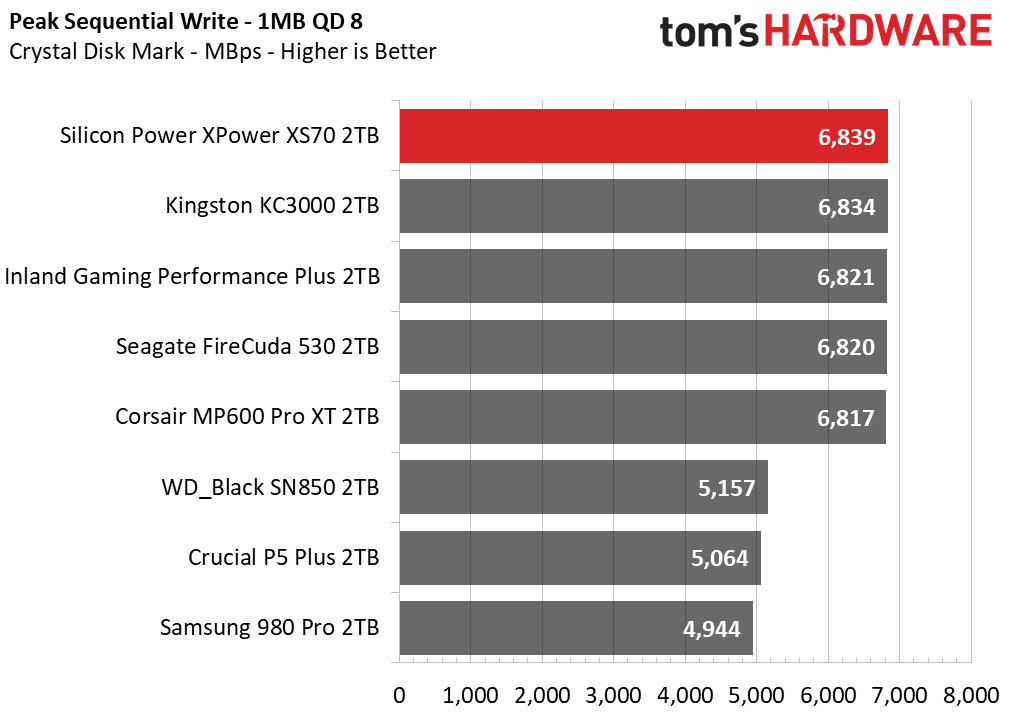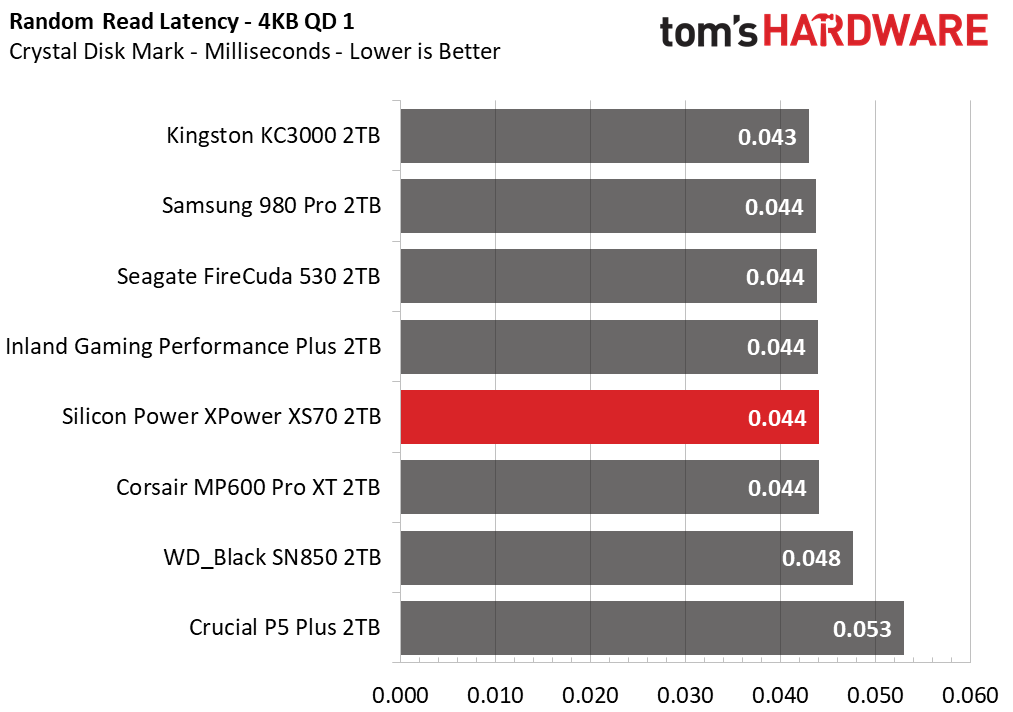Why you can trust Tom's Hardware
Comparison Products
We compare the XS70 to the top PCIe 4.0 drives, including those with the same hardware. The Kingston KC3000, Seagate FireCuda 530, and Corsair MP600 Pro XT all have Phison’s E18 SSD controller paired with Micron’s 176-layer TLC. The other usual suspects are Western Digital’s (WD’s) Black SN850, the Crucial P5 Plus, and the Samsung 980 Pro. Lastly we have the recently-added Inland Gaming Performance Plus that's a direct “gaming” competitor in this space. It has the same hardware with a similar focus on PS5 compatibility and a cooling heatsink. These drives are all 2TB.
Trace Testing - 3DMark Storage Benchmark
Built for gamers, 3DMark’s Storage Benchmark focuses on real-world gaming performance. Each round in this benchmark stresses storage based on gaming activities including loading games, saving progress, installing game files, and recording gameplay video streams.



A gaming drive should do well on this benchmark, and the XS70 does. This is as expected since other E18-based drives, especially those with 176-layer flash, have dominated here. Loading times still rely heavily on latency, so it’s nice to see good performance there. Bandwidth might become more important on the PC in the future due to DirectStorage, but the E18 has it covered.
Trace Testing – PCMark 10 Storage Benchmark
PCMark 10 is a trace-based benchmark that uses a wide-ranging set of real-world traces from popular applications and everyday tasks to measure the performance of storage devices.



PCMark 10 presents itself as a more “real world” benchmark and it is at least useful for illustrating optimization differences. It’s one place we see the P5 Plus and Black SN850 pull away from the Phison-controlled drives, for example. In any case, the XS70 almost precisely matches the Inland Gaming Performance Plus, as we would expect.
Transfer Rates – DiskBench
We use the DiskBench storage benchmarking tool to test file transfer performance with a custom, 50GB dataset. We copy 31,227 files of various types, such as pictures, PDFs, and videos to a new folder and then follow-up with a reading test of a newly-written 6.5GB zip file.


The E18 controller is known for strong sequential performance and we see that here. This is a somewhat realistic burst test, but check the sustained write results to get a better picture for larger transfers. The XS70 throws us no surprises here.
Get Tom's Hardware's best news and in-depth reviews, straight to your inbox.
Synthetic Testing - ATTO / CrystalDiskMark
ATTO and CrystalDiskMark (CDM) are free and easy-to-use storage benchmarking tools that SSD vendors commonly use to assign performance specifications to their products. Both of these tools give us insight into how each device handles different file sizes.














The XS70 shows strong performance with sequential workloads at queue depth 1 within the ATTO test suite, particularly at higher I/O block sizes. This matches expectations from other E18-based drives, regardless of the flash used.
The XS70 also precisely matches E18-based drives with 176-layer flash in the CrystalDiskMark (CDM) tests, although this is one area where WD’s Black SN850 stands out a bit. CDM is a very popular tool for reviewers and enthusiasts as it can give a quick look at performance to see if there’s anything wrong with a new drive, if nothing else.
Sustained Write Performance and Cache Recovery
Official write specifications are only part of the performance picture. Most SSDs implement a write cache, which is a fast area of (usually) pseudo-SLC programmed flash that absorbs incoming data. Sustained write speeds can suffer tremendously once the workload spills outside of the cache and into the "native" TLC or QLC flash. We use Iometer to hammer the SSD with sequential writes for 15 minutes to measure both the size of the write cache and performance after the cache is saturated. We also monitor cache recovery via multiple idle rounds.





The XS70’s SLC caching scheme is reminiscent of the more conservative ones seen in drives like the FireCuda 530, the MP600 Pro XT, and the Inland Gaming Performance Plus. This includes a fast SLC mode, writing at around 6.9 GBps for up to 32 seconds, indicating a cache size of roughly 220GB. This is about one-third of the drive’s native flash being capable of SLC mode, given an empty drive, as opposed to the full-drive SLC caching found in products like the KC3000.
The second performance phase, typically direct-to-TLC, is slower but still much faster than drives with older flash and/or larger caches. Micron’s 176-layer TLC is quite fast in native mode, hitting speeds that would exceed typical PCIe 3.0 limits for consumer drives. This continues on for some time and is also where the drive goes back to when allowed to idle for some time. That is, recovery is not particularly swift, but the drive remains relatively responsive compared to many others.
The final performance state, which is easier to hit when the drive is fuller because there are fewer free blocks and the SLC cache is much smaller, is a bit less than half the native write speed. Cache that shrinks with drive usage is known as dynamic, although it’s also possible to use static or dedicated SLC — which notably is not actual, native SLC — or a hybrid structure as with Samsung’s TurboWrite. It’s worth noting that, due to how flash operates, NAND already performs worse when the drive is fuller, so SLC caching can exacerbate the situation if the cache is exhausted.
The slower state is bottlenecked by 'folding,' which is the copyback mechanism of data from SLC to TLC blocks, with freed SLC blocks converting to TLC. Flash tends to be cycled into SLC mode based on effective wear. This can introduce additive wear or write amplification since data is rewritten. This is related to over-provisioned space, also, because dynamic SLC shares its garbage collection zone with native flash, so erased SLC blocks eventually operate as TLC. In any case, this state is slower because incoming data is first written to SLC, then read from SLC, then finally written to TLC. One reason it’s important to respect this performance state is that latency is increased particularly for incoming information as it must be transferred before being read.
Technical details aside, a more conservative SLC caching scheme — as on the XS70 versus the KC3000 — ensures more consistent performance, particularly in edge cases as with sustained writes on a fuller drive. Steady state or equilibrium performance is also better. This is ideal for a premium drive that’s used for more serious workloads. Of course most consumers, and certainly those focused on gaming, don’t need to be concerned with this. Strong burst performance offered by a large enough SLC cache is usually sufficient.
Power Consumption and Temperature
We use the Quarch HD Programmable Power Module to gain a deeper understanding of power characteristics. Idle power consumption is an important aspect to consider, especially if you're looking for a laptop upgrade as even the best ultrabooks can have mediocre storage.
Some SSDs can consume watts of power at idle while better-suited ones sip just milliwatts. Average workload power consumption and max consumption are two other aspects of power consumption, but performance-per-watt is more important. A drive might consume more power during any given workload, but accomplishing a task faster allows the drive to drop into an idle state more quickly, ultimately saving energy.
We also monitor the drive’s temperature via the S.M.A.R.T. data and an IR thermometer to see when (or if) thermal throttling kicks in and how it impacts performance. Remember that results will vary based on the workload and ambient air temperature.




Power consumption, efficiency, and thermals are only becoming more important in the consumer SSD space. Power draw is increasing in gaming machines and we have PCIe 5.0 SSDs on the horizon. One advantage of newer flash, which includes putting peripheral circuitry under the array but also increasing layer count and die density, is that power efficiency is going up. Controllers still run hotter under peak performance (for example, with longer SLC writes), so SSDs are more often coming with robust cooling solutions. Gaming drives like the XS70 are no different; the drive comes with a thick heatsink, but remains able to fit in the PS5.
The XS70 pulled about as much power as other similarly-equipped drives but still taking more average power than the 980 Pro and Black SN850. This certainly comes from the emphasis on performance in sequential work with the E18 controller, and the large-cached KC3000 is notably the least efficient. The XS70’s considerable heatsink is more stylized than it is effective. That is to say, the drive ran notably hotter than the more functional design on the Gaming Performance Plus. We saw temperatures as high as 73C, although throttling was not an issue.
Test Bench and Testing Notes
| CPU | Intel Core i9-11900K |
| Motherboard | ASRock Z590 Taichi |
| Memory | 2x8GB Kingston HyperX Predator DDR4 5333 |
| Graphics | Intel UHD Graphics 750 |
| CPU Cooling | Alphacool Eissturm Hurricane Copper 45 3x140mm |
| Case | Streacom BC1 Open Benchtable |
| Power Supply | Corsair SF750 Platinum |
| OS Storage | WD Black SN850 2TB |
| Operating System | Windows 10 Pro 64-bit 20H2 |
We use a Rocket Lake platform with most background applications such as indexing, windows updates, and anti-virus disabled in the OS to reduce run-to-run variability. Each SSD is prefilled to 50% capacity and tested as a secondary device. Unless noted, we use active cooling for all SSDs.
Conclusion
Silicon Power’s XS70 finds itself in an increasingly competitive space. We’ve recently reviewed two direct competitors in the Kingston Fury Renegade and the Inland Gaming Performance Plus, but aside from the “gaming”-oriented marketing there are simply a ton of high-performing PCIe 4.0 drives on the market. Gaming at the moment, whether on PC or console, does not benefit much from this extreme level of bandwidth. This may change in the future, particularly when DirectStorage arrives, but there is a limit to how much of a premium you should pay for a small advantage.
Likewise, putting a fancy heatsink on the drive — even if it is PS5-compatible — doesn't make an SSD a gaming drive. It certainly can help with throttling in difficult environments, although a well-ventilated case with a workload that has a minimum sustained writes should have no issues, even with a bare drive. This is especially true with the more efficient 176-layer flash we see on this drive. That said, the drive is attractive and a heatsink does offer some cooling even if it’s mostly for looks, although perhaps form should not be prioritized over function. The real question is: how much value does it add when considering the price?
Luckily, the XS70, as priced during the writing of this review, is affordable relative to the other options. Considering it has high-end hardware and a 4TB option, this is no small favor. Silicon Power of course had this advantage also with the P34A80, so it’s nice to see the company returning to that approach. One can only hope they don’t decide to switch the hardware later as they did on that drive. As is, it’s equally capable as any competitor and only lacking in the software department. To be fair, that's not critical for PS5 usage in any case.
The SLC cache design is also more conservative (the cache is smaller), allowing for higher post-SLC performance. This is not usually relevant for gaming usage, although it can be nice to have in some cases with a fuller drive and extreme updates. That being said, it enables the drive to be used for much heavier workloads if the need ever arises. Considering that higher-capacity drives are on the way and a user might prefer that for a gaming drive, this does add some long-term versatility.
On the whole, there’s little not to like about this drive, and we rather like the design and pricing. It doesn’t offer anything special over other drives that use the same hardware, but that’s not a bad thing. We can easily recommend this drive as a premium option for any user, particularly at 2TB.
MORE: Best SSDs
MORE: How We Test HDDs And SSDs
MORE: All SSD Content

Shane Downing is a Freelance Reviewer for Tom’s Hardware US, covering consumer storage hardware.
-
tamalero Those prices looks really good. I hope this isnt part of the plan of doing a bait and switch like many NVME and SSD vendors have done lately.Reply -
Reply
You can expect that from almost every manufacturer of SSDs except perhaps the top-tier like Samsungtamalero said:Those prices looks really good. I hope this isnt part of the plan of doing a bait and switch like many NVME and SSD vendors have done lately. -
markmcg Reply
Dunno what you think affordable...but it is £330 on Amazon for 1TB 😒Admin said:We put the blistering-fast Silicon Power XPower XS70 SSD through its paces in our test regimen.
Silicon Power XPower XS70 SSD Review: Fast, Attractive, and Affordable : Read more
Unless you know different? 😏 -
tamalero Reply
And? just because others do, doesn't means its good.Mandark said:You can expect that from almost every manufacturer of SSDs except perhaps the top-tier like Samsung -
Reply
No I was just saying expect it and that you should stick with good manufacturers like Samsung. I never once said that it was goodtamalero said:And? just because others do, doesn't means its good. -
alceryes After researching a bit, I just pulled the trigger on this.Reply
SP is selling the 2TB version, through Amazon, for $169 USD. Hard to beat for the purported performance. I'll be taking the heatsink off since the motherboard I'm getting has a heatsink already. -
Pyrokinetic Buyer beware!Reply
Be warned - new XS70 2TB units no longer use the Phison E18 controller. Unit I just bought only scored 1976 in the 3dMark Storage Benchmark. Love the language on the website -- performance figures are "up to" figures of the E18 unit. Bait and switch losers - need to rename it something else.
